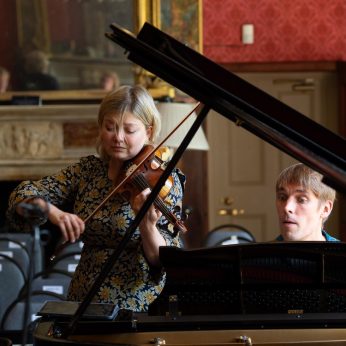Composer: Robert Schumann (b. 1810 - d. 1856)
Performance date: 24/06/2023
Venue: Bantry House
Composition Year: 1851
Duration: 00:17:08
Recording Engineer: Tom Norton, RTÉ
Instrumentation: vn, pf
Instrumentation Category:Duo
Artists:
Alina Ibragimova -
[violin]
Cédric Tiberghien -
[piano]

Violin Sonata No.1 in A minor Op.105 [1851]
1.Mit leidenschaftlichem Ausdruck
2. Allegretto
3. Lebhaft
By 1850, when Schumann moved to Düsseldorf as their municipal Music Director, he was considered by many to be Germany’s greatest living composer. Schumann was not a success as a conductor as he was gradually losing touch with reality, but in the four years 1850-54 he hardly seemed to stop composing. For a long time these late works of Schumann were dismissed as the ramblings of a diseased mind, a campaign, it has to be said, begun by Clara, his long-suffering wife, who could never be accused of disloyalty. However posterity has grown kinder and we marvel that these works once were rejected.
His style had moved a long way from the miraculous youthful piano works, that unstoppable flow of ideas that seemed to trip up over each other in their desire to reach the page had been replaced by a more serious muse, who could replace unceasing invention with masterly structures and a sure grasp of form. Three violinists inspired this late flurry of violin music, Ferdinand David, leader of the famous Leipzig Gewandhaus Orchestra and co-founder with Mendelssohn of the Leipzig Conservatory, Joseph Wasieleweski leader of the orchestra in Düsseldorf and of course the young Joseph Joachim, already a famous virtuoso. The first two sonatas followed each other in the autumn of 1851, while the three works for Joachim date from his last autumn of sanity in 1853.
The First Sonata is alone among Schumann’s symphonically conceived chamber works in being cast in three movements, rather than four, with the Allegretto combining the functions of slow movement and scherzo. The passion of the opening bars of the Sonata is expressed largely through much use of the rich and intense tone of the violin’s bottom G string. The main theme, with its turbulent piano accompaniment, unfolds as though in a single breath and in a stroke of inspiration the second subject with its striking refrain flows unimpeded out of the transition. A similar overlap occurs at the start of the recapitulation. Here, as the development is still reaching its conclusion, the violin gives out the main subject’s phrase in an achingly expressive broadened form, and the original tempo is not picked up again until the theme is already in mid-flow.
The Allegretto’s main theme, with its phrases culminating in a ritardando followed by a long-held pause, is serene enough to afford the necessary feeling of repose between the Sonata’s passionate outer movements. The first reprise of the theme gives way to an episode in a quicker tempo whose flow is touchingly interrupted by a long-held violin note behind which the sound of hunting-horns can be heard on the piano, changing from major to minor. At the end, with a gently rustling sound followed by two pizzicato chords, this delicately scored piece disappears into thin air.
The unstoppable semiquavers of the finale’s theme permeates not only the movement’s outer sections, but also the passionate episode in the major at its centre. During the closing pages the violinist unobtrusively slips in the expressive version of the main theme from the opening movement with an underlay of a new triplet rhythm in the piano, a brief interlude in the finale’s restless motion.
Francis Humphrys
Copyright © 2025 West Cork Music. All rights reserved.
Designed and developed by Matrix Internet